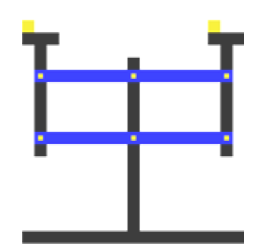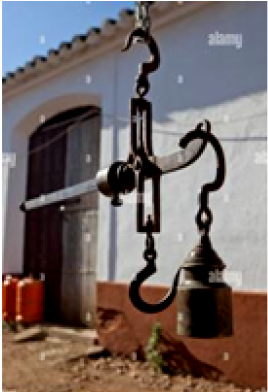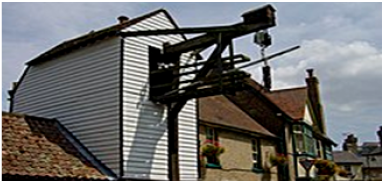Crude weighing beams having a nail for centre pivot and wire rings passing through holes near
ends of the suspension of strings carrying wooden pans or platters were used in farm houses for
weighing butter up to the end of the 19th century.
The needs of the alchemists and the early assayers for accuracy in the work probably encouraged the inventors during the 16th and 17th centuries and finally the true knife edge emerged.
The needs of the alchemists and the early assayers for accuracy in the work probably encouraged the inventors during the 16th and 17th centuries and finally the true knife edge emerged.

Figure shows stages in the evolution of knife edge, and of the methods of forming or fixing it in the varioustypes of beam ends, such as the swan -neck, the box end, and the dutch end.

COUNTER SCALES
In 1669 Gilles de Roberval invented what is known as the “ Static Enigma”
which puzzled the greatest mathematicians of the day, although an average
engineering student of the 20th century would have no difficulty in explaining
mechanics of device. In this the beam, legs and stay forming th system make
perfect parallelograms.


Not until the beginning of the nineteenth century did the scale makers
apply this principle to the balance , but since then the Roberval enigma
has formed the basis of many counter scales
The beam scale, counter scale all of which incorporate an equal armed
lever or beam, yield no mechanical advantage, loads counter balance
by weights.
BISMAR STEELYARD
Bismer balances were first developed either in India where
they appear in writings and art,or around the Mediterranean
where they subsequently made their way to India.
The Bismar is one of the simplest and yet least known of all weighing instruments. It is really a counter- weighted lever used to balance the load to be weighed, and an idea of how the device was used may be obtained from the figure.
The Bismar is one of the simplest and yet least known of all weighing instruments. It is really a counter- weighted lever used to balance the load to be weighed, and an idea of how the device was used may be obtained from the figure.

The loose loop of cord forming the fulcrum is moved along the lever until the position of the
balance is reached. In old bismars, nail heads served to mark the graduation.
Both the place and time of origin of the Bismar are obscure and its distribution was very
wide. Among the countries where it has been used are India, Burma, Malaysia, Denmark and
Scandinavia. The Danish invaders introduced it into Britain in the 8th century, and it was in
use for the trade purposes until made illegal in the reign of Edward lll.
Like the crude forms of the balance, the Bismar has remained in use throughout the centuries,

The principle of using a sliding poise on the arms of a beam to
counter-balance a load was probably discovered by the Greek-speaking
people of Campania, and led to the evolution of the Roman Steelyards at
a time somewhat later than the invention of the Bismar.
The earliest Roman steelyards were fitted with ring and hole pivots. Many centuries passed after the fall of Roman Empire before a properly constructed pivot or knife edge was fitted to these steel yards.
A steel yard balance or steelyard is a straight – beam balance with arms of unequal length. It incorporates a counter weight which slides along the longer arm to counter balance the load and indicate its weight. A steelyard is known as a Roman steelyard or Roman balance.
The earliest Roman steelyards were fitted with ring and hole pivots. Many centuries passed after the fall of Roman Empire before a properly constructed pivot or knife edge was fitted to these steel yards.
A steel yard balance or steelyard is a straight – beam balance with arms of unequal length. It incorporates a counter weight which slides along the longer arm to counter balance the load and indicate its weight. A steelyard is known as a Roman steelyard or Roman balance.
Very large suspended steelyards were on use until the end of 18th
century for weighing carts, until the invention and general
introduction of the compound lever platform scale.
